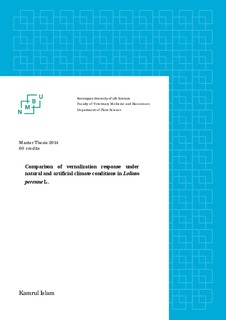| dc.description.abstract | Forage grasses like perennial ryegrass (Lolium perenne L.) and Festulolium are extensively cultivated worldwide and constitute primary feed for ruminants due to their high nutrient value, high palatability and digestibility. Perennial ryegrass usually needs vernalization treatment (prolonged exposure to low temperatures) to initiate flowering. Vernalization requirement is particularly important for preventing flower development during winter and protect the environmentally sensitive floral organs. Understanding the control of flower initiation and flowering time in diverse plant species gives us insights into the ancestral control of flowering time and the evolution of alternative mechanisms in different plant lineages. Vernalization requirement of perennial ryegrass is often determined using controlled climate conditions. In order to study natural adaptation during autumn and winter, gene expression can also be studied by sampling under field conditions. Under natural field conditions, climate variations are much greater since temperature, light intensity and photoperiod are not controlled. In this thesis, investigations were undertaken, therefore, to determine gene expression of genes involved in vernalization in perennial ryegrass under field conditions. Gene expression patterns at different time points of plant growth throughout the winter were detected for the vernalization genes VRN1, VRN2, and VIN3 using qRT-PCR. Plants were established, cold hardened at 2-6 0C for 2 weeks and continue their life cycle with temperature fluctuations ranging from -10 ºC to +6 ºC. The relative gene expression of the three target genes was measured in two genotypes from the Norwegian cultivar ‘Fagerlin’, i.e. genotype 201 (flower without vernalization) and genotype 204 (require vernalization to flower). The results indicate that there is a differential gene expression pattern for vernalization genes. Increased transcript levels for VRN1 and VIN3 genes in response to cold stress were observed during the mid-December to mid-January (-6 to -10) 0C period for both genotypes, whereas VRN2 expression is low and was not affected by vernalization in both genotypes. The expression levels of VIN3 were correlated with VRN1 with similar expression patterns. Under controlled conditions, both genotypes underwent two types of treatments, i.e. the first treatment with vernalization followed by cold hardening, de-hardening, and re-hardening, and the second treatment was conducted same as first treatment but without vernalization. The results show that both VRN1 and VIN3 were upregulated during cold hardening and downregulated during the de-acclimation period. We also investigated the gene expression patterns of VRN1, VIN3, fructan and dehydrins in two genotypes of Festulolium, i.e. genotype 266 (flower without 10 vernalization) and genotype 329 (require vernalization to flower) at controlled conditions with two treatments as mentioned before. The expression pattern of VRN1 in Festulolium with the vernalization treatment followed by cold hardening, de-hardening, and re-hardening showed increased expression level in cold hardening and re-hardening for 329 genotype. The relative expression of VIN3 gene was upregulated without the vernalization treatment followed by cold hardening, de-hardening, and re-hardening. The fructan gene expression was observed in vernalization treated conditions for both 329 (de-hardening treatment) & 266 genotypes (dehardening & re-hardening) of Festulolium. Dehydrins also activated by exposure of cold temperature and increased transcript level was observed in cold hardening and re-hardening conditions for 329 genotype of Festulolium. Further, we validated the gene expression data by comparing to the RNA transcriptome data of all these genes. | nb_NO |
